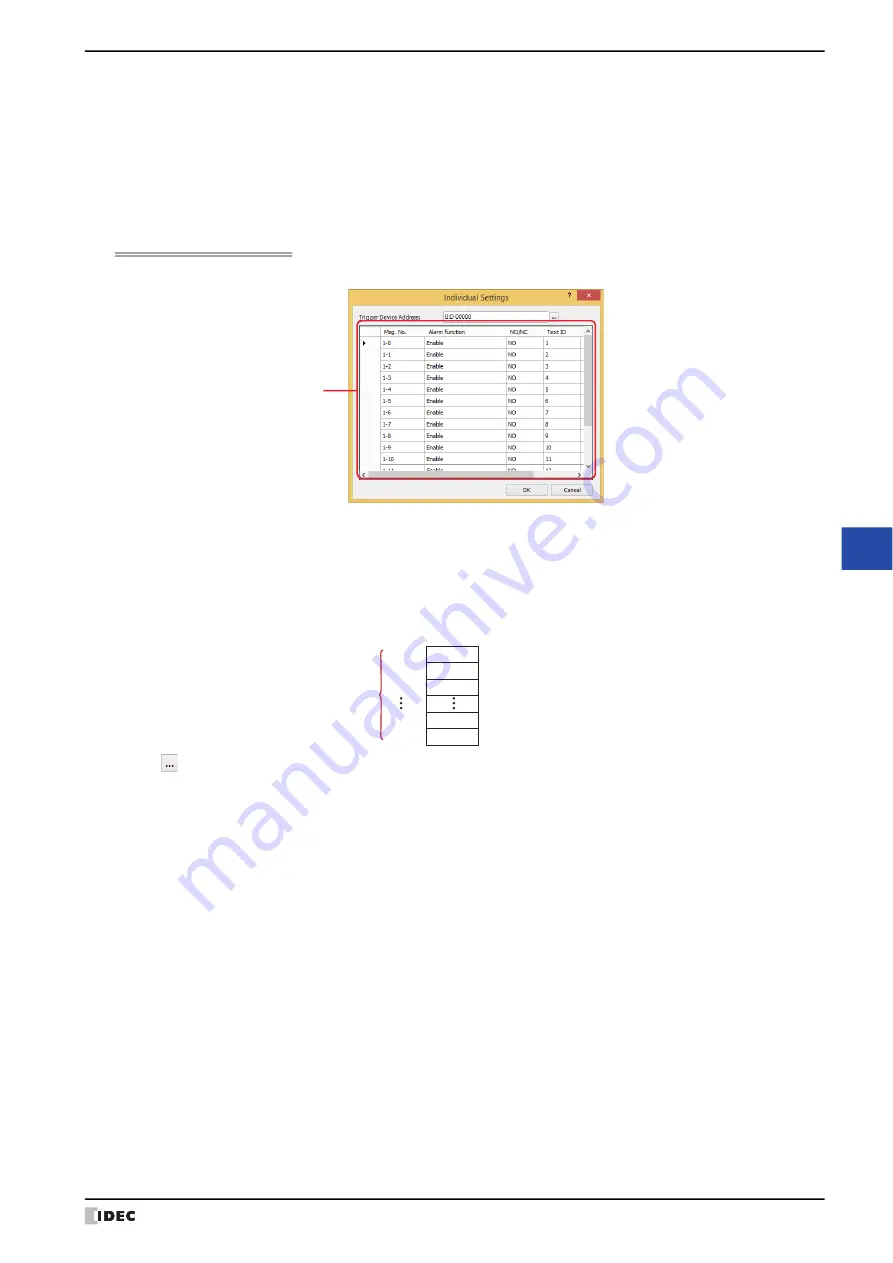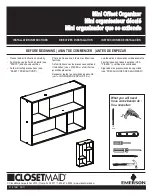
WindO/I-NV4 User’s Manual
10-141
7 Alarm List Display
10
Da
ta
D
isp
la
ys
Individual Settings Dialog Box
The
Individual Settings
dialog box is used to configure the conditions to display the messages.
■
Trigger Device Address
Specifies the word device to use as the condition to display messages. The word device bits correspond to the
message numbers.
Click
to display the Tag Editor. For the device address configuration procedure, refer to Chapter 2 “5.1 Device
Address Settings” on page 2-70.
When
Serial
is selected for
Device Address Setting Method
on the
List
tab, the trigger device addresses for block
numbers after the block number being registered or edited are automatically changed with the configured trigger
device address as the starting address.
■
(Settings)
Insert:
Inserts the block settings in the position selected on the list.
Select the block number at the position to insert the settings in the list and click this button
to display the
Individual Settings
dialog box. For details, refer to “Individual Settings
The settings at the insertion point shift down one line. Settings cannot be inserted if all
block numbers are configured.
Delete:
Deletes the registered settings from the list.
Select a block number on the list and click this button to delete the selected settings from the list.
(Settings)
Example: When the number of blocks is 1 and D0 is specified as the trigger device address
The device address of the number(Block Number - Message Number) 1-0 is D0-0, the device address of the
number 1-1 is D0-1, ... the device address of the number 1-15 is D0-15.
D0-0
D0-1
D0-2
D0-14
D0-15
1-0
1-1
1-2
1-14
1-15
Block 1
16 channels
Number(Block Number - Message Number)
Device Address
Msg. No.:
Displayed as (Block No.)-(Message No.).
Alarm function: Selects whether or not to use the alarm function. Double clicking the cell switches between
Enable
and
Disable
.
Enable: Monitors the state of the device address bit configured for the channel and displays the
message.
Disable: The device address bit is not monitored and the message is not displayed.
NO/NC:
Selects the alarm detection condition. Double clicking the cell switches between
NO
and
NC
.
NO:
Displays the message when the monitored bit changes from 0 to 1.
NC:
Displays the message when the monitored bit changes from 1 to 0.
Text ID:
Shows the Text Manager ID number (1 to 32000) to use for the message.
The text ID is sequentially configured starting with the text ID configured by
Start Text ID
on the
List
tab.
Text:
Shows the text for the specified text ID.
Only shows the first line of text when the text registered to the text ID has multiple lines.
Summary of Contents for WindO/I-NV4
Page 1: ...B 1701 16 User s Manual...
Page 108: ...5 WindO I NV4 Common Operations and Settings 2 76 WindO I NV4 User s Manual...
Page 256: ...7 BACnet Communication 3 148 WindO I NV4 User s Manual...
Page 372: ...6 Screen Restrictions 5 32 WindO I NV4 User s Manual...
Page 390: ...5 Part Library Function 6 18 WindO I NV4 User s Manual...
Page 420: ...3 Text 7 30 WindO I NV4 User s Manual...
Page 628: ...2 Multi State Lamp 9 34 WindO I NV4 User s Manual...
Page 924: ...4 Meter 11 76 WindO I NV4 User s Manual...
Page 990: ...7 Timer 12 66 WindO I NV4 User s Manual...
Page 1030: ...4 Using Data and Detected Alarms 13 40 WindO I NV4 User s Manual...
Page 1098: ...4 Using the Data 15 22 WindO I NV4 User s Manual...
Page 1248: ...5 Restrictions 22 18 WindO I NV4 User s Manual...
Page 1370: ...2 Monitoring on the MICRO I 25 28 WindO I NV4 User s Manual...
Page 1388: ...4 Restrictions 26 18 WindO I NV4 User s Manual...
Page 1546: ...5 Module Configuration Dialog Box 30 36 WindO I NV4 User s Manual...
Page 1614: ...3 Settings 34 14 WindO I NV4 User s Manual...
Page 1726: ...5 Text Alignment A 10 WindO I NV4 User s Manual...


































